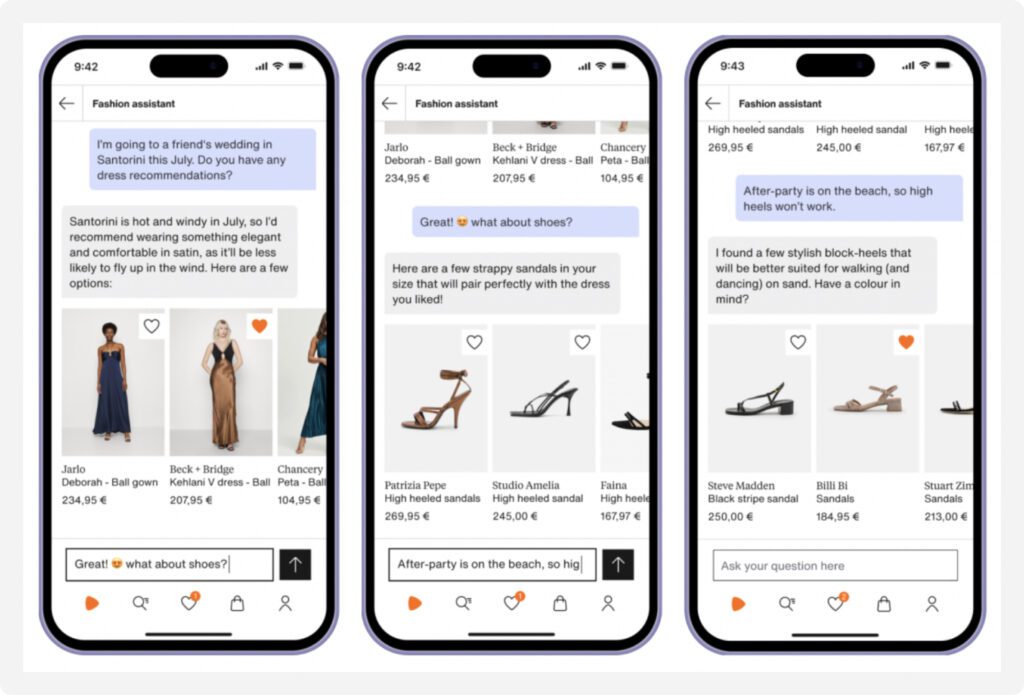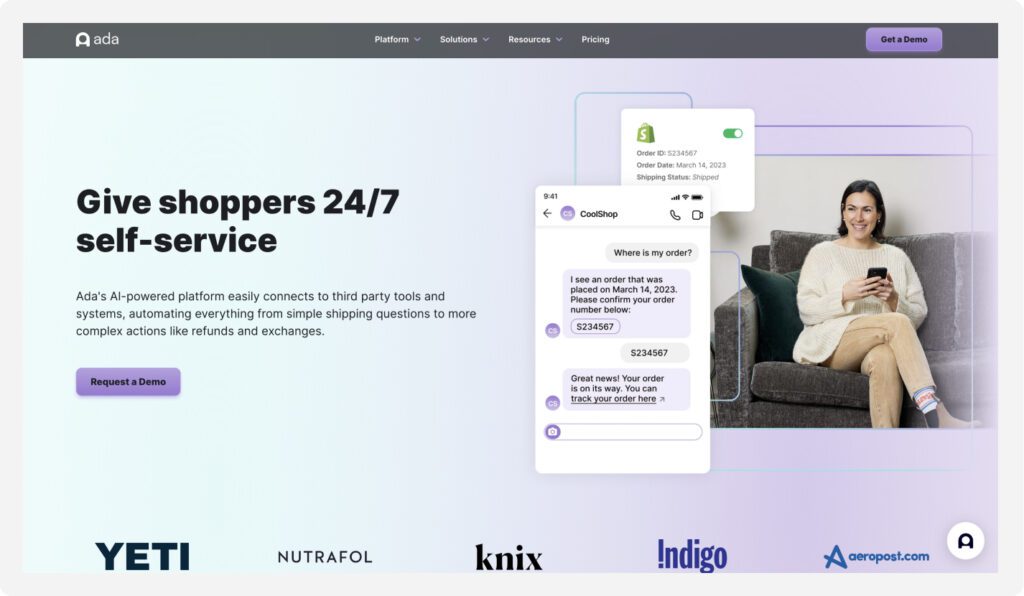Digital shopping experiences are evolving rapidly due to advances in technology and shifts in consumer demands. One of the most significant retail tech advances in recent years has been the emergence of artificial intelligence (AI).
AI is already improving retail operations like supply chain optimization, inventory management, and logistics. In-store, the tech enables real-time price adjustments and bolsters security measures to minimize fraud in transactions.
As analytical AI continues to impact retail operations, an evolution in AI is transforming online shopping experience – the emergence of generative AI.
Generative AI represents a major advancement in the field of artificial intelligence. Unlike analytical AI systems that rely on existing data and patterns, generative AI can create new patterns autonomously. As the technology evolves, it will provide new opportunities for businesses to design increasingly immersive and personalized shopping user experiences.
Analytical versus Generative AI: Understanding the Fundamental Differences
Analytical AI and generative AI are two distinct branches of artificial intelligence, each with unique capabilities and applications. As the landscape of AI evolves, the differences between these two branches become increasingly significant, especially as we consider how they shape online shopping experiences.
Analytical AI, sometimes called traditional AI, primarily focuses on extracting insights from data through analysis, prediction, and pattern recognition. It operates based on predefined rules, algorithms, and statistical techniques to uncover trends and correlations within datasets.
This approach is highly effective for tasks that involve making predictions or recommendations based on historical information. For instance, in the context of digital shopping, analytical AI is used to analyze past purchasing behaviors, browsing histories, and demographic data to predict customer preferences and suggest relevant products. An example of this is Amazon’s recommendation engine, which suggests products based on a user’s previous interactions on the platform.
Generative AI, on the other hand, stands at the forefront of creative AI applications. Unlike analytical AI, generative AI doesn’t rely solely on historical data and predefined rules. Instead, it learns from existing data and generates new content that possesses similar characteristics and patterns to the input data.This branch of AI, used in applications like ChatGPT and DALL-E 2, excels in tasks involving creativity, imagination, and content generation.
The key distinction between these two types of AI is their output. Analytical AI generates insights and predictions based on past data, aiding businesses in making informed decisions. Generative AI, however, generates novel content that has the potential to engage, inspire, and captivate users.
In the context of digital shopping experiences, generative AI holds immense potential to reshape interactions between consumers and retail businesses.
Using Generative AI to Deliver Tailored Online Shopping Experiences
As consumer expectations continue to evolve, retail businesses will confront new challenges and opportunities. Today’s consumers have higher expectations for more personalized, interactive, and engaging shopping experiences. Research from McKinsey shows that 71% of customers expect personalized experiences from retailers, 67% start their journeys on mobile devices, and 55% want contextually relevant interactions.
To meet these rising consumer demands in the digital era, more and more retailers will turn to generative AI to take their customer experiences to the next level. By leveraging its capabilities, businesses can create an ecosystem where personalization, seamlessness, creativity, and real-time CX converge to transform retail UX and create next-generation shopping experiences.
Here are five ways generative AI is revolutionizing consumer shopping experiences:
1) Providing Hyper-Personalized Recommendations
The current experience of discovering relevant products on a website is tedious. You type something broad into a search bar or hover on a generic navigation item like ‘Men’ to open a mega-menu of options. Now, you have a product listing page that you can scroll through before you decide to filter the results by category, size, color, pattern, price, etc.
It’s an unsatisfying experience that requires several steps and doesn’t accurately reflect your need. Generative AI can make the traditional search, refine, and browse user experience more intuitive by providing recommendations based on customer inputs.

The Zalando fashion assistant, shown in this chat interface, uses ChatGPT to help customers find the right products. Source: https://corporate.zalando.com/en/technology/zalando-launch-fashion-assistant-powered-chatgpt
The German retailer Zalando is launching a ChatGPT-powered digital fashion assistant to recommend products to customers. The customer can describe what they are looking for in their own words, and the assistant will make recommendations. For example, a customer might write, “What should I wear to a street festival in New York in July?” The assistant will recognize the event as informal and know the weather in New York in July to provide recommendations. It will also describe why it’s making the recommendation.
As the system learns about the user’s preferences, the recommendations become even more personalized. Perhaps you love yellow, cringe at denim, and have sworn never to wear a pair of Birkenstocks. Bye-Bye filters. This experience definitely exceeds the traditional search, refine, and browse experience.
2) Generating Product Visualizations Tailored to Specific Needs
You’re shopping for a new outfit, and you’ve narrowed it down to a few options. The color and pattern are spot on, and you like the sheen on the material. But it’s a struggle to visualize the fit. What size should you buy: a medium or a large?
Unfortunately, product photography typically doesn’t help customers make fit choices due to the limited diversity of models. When the photos don’t broadly represent different people, customers often face the following problems:
- Unable to visualize fit: If all models wearing the clothes are very thin or of a particular body type, it’s difficult for those with different body shapes to judge the actual fit and drape of the garment.
- Unsure if styles suit them: When models don’t represent diverse ages, sizes, skin tones, etc., many consumers struggle to determine if certain styles and looks would be flattering on them.
- Feeling excluded & unsupported: A lack of diversity in brand imagery can make large consumer segments feel excluded and unsupported. These feelings creates a negative emotional experience.
Shoppers who engage in experiences with no relatable imagery to use for reference tend to lack confidence in whether something will work for them. This leads to hesitation, higher return rates, and wasted money on ill-fitting clothes. Furthermore, shoppers who can’t see themselves reflected in a brand’s website often feel turned off and avoid shopping there altogether, shrinking the brand’s customer base.

Veesual’s software helps shoppers visualize fit selection by rendering different garment sizes on models the shopper has selected. Source: https://www.laredoute.fr/
Companies like Veesual and Botika use generative AI to help improve the poor UX customers encounter when there is limited diversity in model photography. These companies provide software allowing shoppers to view outfits on AI-generated models with appearances the shopper has selected for morphology, skin color, and hair.
While broadly, both companies focus on reflecting shopper diversity; there are nuances in their interactive product visualizations. For example, the French company Veesual focuses on the precision of fitting. Their software helps shoppers with size selection by rendering different garment sizes on models.
3) Helping Marketplace Sellers Create Dynamic Content for Listings
Marketplaces like Amazon, Etsy, and eBay allow people to sell products on their platforms. The onboarding processes are relatively similar. Create a shop or seller’s account, upload information and photos about your product, select pricing and shipping options, and make the listing public. The process is tedious, particularly for first-time sellers who want guidance on optimizing listings for discoverability. Common questions sellers struggle with include:
- How long should my title be? How can I optimize it for search?
- What’s the best structure and length for an effective product description?
- How many photos should I include, and what angles work best?
- What is the ideal pricing strategy – start high or low?
- How granular should I get with item specifics like brand, material, etc.?
The product listing UI tries to answer these questions using helper text to guide sellers on best practices. Unfortunately, it can be overwhelming, as seen in the Etsy listing details. Better dynamic content tools and guidance while writing could help reduce UX friction in the seller experience.

Etsy’s listing details UI relies heavily on helper text to guide seller content creation. It’s overwhelming and doesn’t help the seller create content as they are actively writing titles and descriptions.
New generative AI tools can dynamically create more relevant product descriptions, titles, posts, and other custom content to help sellers better position their products in the marketplace. For example, Amazon is testing a generative AI tool to help sellers write more appropriate product titles and descriptions to improve listing engagement. Better product content helps buyers find their desired products more quickly and enhances the seller experience as listings receive more interactions.
4) Turning Clunky Bot Interactions Into Intelligent Human-like Conversations
Ask a chatbot a simple question like “Where are my order details?” And guess what? You may find yourself stuck in a repetitive loop, repeatedly providing shipping dates and order numbers as the bot fails to understand your initial request. Chatbots were supposed to provide a convenient, seamless customer experience. Yet many users still find themselves frustrated by robotic conversations that lack the nuance of human empathy and interaction.
The root of these chatbot friction points stems from limitations in natural language processing and conversational context. Without the ability to interpret language fluidly or maintain context, chatbots force users to conform to rigid, predetermined paths rather than accommodating unique needs.

Ada’s platform helps apply generative AI to customer experience. https://www.ada.cx/
While first-generation chatbots have fallen short in providing seamless conversational experiences, advances in generative AI present new opportunities. Companies like Ada are using large language models (LLMs) to understand nuanced natural language queries without the constraints of rigid programming.
These new generative AI chatbots can fluidly adapt to unique conversational paths rather than following predetermined flows. Their ability to comprehend context and reciprocate relevant responses reduces frustrating repetition.
Generative AI also enables greater personalization based on individual user history and preferences. With these human-like capabilities, generative chatbots can deliver intuitive, natural dialogue while resolving customer needs more efficiently.
As this technology continues maturing, it has the potential to finally provide the effortless, satisfying user experience that chatbots have thus far struggled to perfect. Brands that leverage generative AI will gain a competitive advantage by reducing friction points and exceeding customer expectations.
5) Bridging the Online Furniture Shopping Divide with Generative AI
One of the biggest challenges of shopping for furniture online is that it’s difficult to get an accurate sense of the size, quality, and look of pieces.
For example, imagine shopping on Wayfair for a new couch. You found one you liked at a reasonable price, but the product photos only showed it from several angles, making it difficult to tell if it’s large enough for your living room.
The inability to fully experience a big purchase like furniture through a website creates a disconnect and makes the shopper unsure if they’re making the right choice. This inability to physically see, touch, and interact with products is an inherent friction point of online furniture shopping.
Emerging technologies are starting to address this issue and reduce the disconnect between virtual and in-person furniture shopping. Generative AI can now create 3D renderings of products that allow you to view furniture from every angle and visualize how pieces fit into your unique space.
IKEA is one brand at the forefront of leveraging AI to improve the online customer experience. They recently partnered with a generative AI company to launch a feature that allows you to visualize IKEA products in your own space. After uploading a photo of your room, you can browse 3D models of IKEA furniture and seamlessly place them into your existing setup.
The AI adjusts the lighting and shadows to make the renderings look realistic. This makes it much easier to understand a product’s actual size, aesthetics, and fit. IKEA also uses AI to generate additional product shots from different angles, allowing online customers to see pieces from every perspective.
By implementing these AI-powered visualizations, IKEA is reducing the guesswork of online furniture shopping and minimizing returns and dissatisfaction. Generative AI gives consumers more confidence in finding pieces that suit their needs and style.
As Customer Expectations Evolve Generative AI is Reshaping Online Retail Experiences
Customer expectations for retail shopping experiences are higher than ever. People want personalized, visually appealing, and on-demand engagements across channels. Generative AI presents an enormous opportunity for brands to transform retail UX by delivering tailored digital experiences that exceed these new expectations.
personalization, customized product recommendations, immersive interactions, and contextual conversations are creating shopping experiences that feel like the future today. Adopting generative AI is becoming a competitive necessity for retailers in order to continue attracting, engaging, and exciting consumers. This powerful technology will only grow more prevalent as retailers compete to provide the tailored, interactive experiences consumers now demand.
Make Decisions Grounded in Customer Insights & Design Better Products
Everyday Industries is a UX strategy and digital product design studio. Learn how our UX and digital product design services can help you design experiences that connect with your customers and drive business growth.

